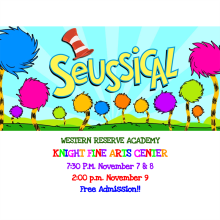
All are welcome to join us in the Knight Fine Arts Center for our Fall Musical: Seussical!
Friday, Nov. 7 | 7:30 p.m.
Saturday, Nov. 8 | 7:30 p.m.
Sunday, Nov. 9 | 2 p.m.
Admission is free with open seating. Click here to access the full cast list.
++
On a damp October evening, in the height of rehearsal season, the Knight Fine Arts Center auditorium hummed with the kind of chaos only a late-night practice can bring: the faint smell of sawdust, the shuffle of sneakers on stage, the overlapping hum of voices half in character and half in conversation. Offstage, a small group of students (Whos, technically) gathered around the piano. Their maestro, Director Midge Karam ’79, had asked them to meet and after getting called away briefly, she was on her way, ready to take charge. She found them already counting themselves in.
“Okay, let’s do it! One, two, three —!”
They began to sing.
“I didn’t even have to say anything,” Karam said, still marveling at the moment. “They just did it. I think they wanted to impress me.”
That instinct, to create, to take ownership, to delight, sits at the heart of this year's fall musical, Seussical, a gleeful collage of Dr. Seuss stories bound together by rhythm, rhyme and improbable coherence. In choosing it, Karam wanted something more than spectacle.
“I knew I wanted an ensemble show,” she said. “Something joyful, something that would build community.”
She paused, as if searching for the right phrase, and then found it: “At its core, Seussical is about everybody mattering.”
A World Made of Whimsy and Work
The story begins in a child’s imagination. A boy conjures a cat (with a hat), the cat conjures a world and before long, we’re inside an explosion of Seussian logic, where Horton the Elephant is both caretaker and philosopher, and Whoville hums precariously atop a speck of dust. It’s a show that demands invention, and at WRA, invention is abundant.
In her research, Karam stumbled upon a community-theater production in Columbus that cast performers from ages six to sixty. “There was this one kid,” she recalled, laughing. “He couldn’t sit still. But the cast just went with it. They made space for him. That’s the spirit I want to capture.”
Back on campus, her cast and crew have embraced this ethos wholeheartedly. “Our students are so busy,” Karam said. “They have academics, sports, college applications, volunteer opportunities, study hours — but when they’re here, they’re here. They bring their whole selves.” She specifically named a senior trio, a famously friendly fixture of three on campus: Jayden Kersh ’26, Finn Frato-Sweeeny ’26 and Caz Badynee ’26. On stage, they’re the Wickersham Brothers, and each night, their arrival to KFAC “just shifts the whole energy of the room.”
And then there are the students whose strengths unfold behind the curtain: Nadia Kischke ’26, who has stepped into a leadership role assisting Director of Dance Katie Velbeck with choreography; Ella Harvey ’27, who doubles as Mrs. Mayor and choreographed for Whoville; Kongkona Goswami ’27, who has taken the reins of lighting design; Maggie Fisher ’26, stage manager for her first-ever production; Maliah ONeal ’28, Zizi Moore ’28 and Lillian Kercher ’26, whose hours on the costume design clock extend around the log sheet.
“Everyone involved has been remarkable,” said Karam, a sentiment echoed by Technical Theater Director Brandon Davies and Fine & Performing Arts Chair and Costume Designer Carol Parker Mittal. “They’ve turned this into something that belongs to everyone.”
Hudson, Reimagined
If the play’s thematic compass points toward community, its visual compass points — surprisingly — to Hudson, Ohio.
“During one of our initial meetings about the show, Midge pitched the idea of Whoville looking like Main Street,” said Davies. As a result, his Whoville is equal parts architectural homage and optical trick. You’ll see a clock tower that’s a little crooked, possibly a bookstore, all things familiar yet skewed. It’s Hudson, but through the eyes and imagination of a child.
To bring that dreamlike quality to life, Davies immersed himself in the visual language of Dr. Seuss and the warped geometry, impossible angles and playful distortions that define his worlds. “It’s an interesting study in perspective,” he said. “Dr. Seuss took things that could exist and just removed the logical structure. It’s about making the world feel slightly off-kilter — in a good way.”
Lighting also plays a prominent role in placesetting. Goswami, who discovered her passion for light design in Davies’ stagecraft class, is overseeing the entire light design. “Light tells a big part of the story, and it can for so many shows,” said Davies. “It shifts tone, indicates space, even emotion. And last year, we bought new moving lights — so expect a few surprises!”
He pointed to two newly installed, large, modern light domes affixed to the rafters above. He beamed with obvious excitement, but beneath it lay something serious: an artist's reverence for learning. “Every show you design teaches you something,” said Davies. “When we announce a show, I never think to myself, oh, I’ve got this in the bag. Theater doesn’t really let you. You have to stay creative, stay challenged, keep learning. Honestly, it’s the best part of what I get to do.”
Thread and Transformation
While Davies builds worlds from light and lumber, Parker Mittal does it with fabric and thread. Her aesthetic for Seussical is varied — an era of mod simplicity colliding with cartoon exuberance.
“Whoville is more structured,” she described. “Pinks, greens, yellows, clean shapes and color blocking. The Jungle is more chaotic. A full rainbow, anchored in black.”
For Parker Mittal, the work sits at the intersection of precision and play. You can’t pull most of these costumes out of the closet. And even when you can pull some select pieces — like a black tailored suit for one of the Cat in the Hat’s many costume changes — you have to adapt it, make it sing. Add a fluffy white vest and bright red buttons. Make it easy to get in and out of so the Cat in the Hat (Will Sirak ’27) can jump to the next costume, the next scene, without delay.
Inside the costume studio are racks of completed pieces, neatly constructed in adorable Whoville shades and patterns, while the Jungle attire would make any style aficionado envious. By opening night, every student in Parker Mittal’s design class will have completed a garment for the show.
Parker Mittal has even brought in an expert on hair who will instruct students on how to wear and style wigs for the show. “For dress rehearsal and show nights, some of our students will come in two hours early for hair, makeup, mic checks,” she explained with quiet pride in her voice. By the time the curtain rises, they will have already transformed.
The Serious Business of Joy
For all its whimsy, Seussical carries serious themes: self-worth, compassion, community, the radical idea that “a person’s a person, no matter how small.” These aren’t just Seussian morals, they’re the play’s architecture and, in Karam’s mind, the school’s too.
“With our Bicentennial coming up, we could have chosen something more historical, something rooted in the past,” she said. “But Seussical felt right. It’s new, we’ve never staged it, yes, but it’s also about foundations, about how imagination and care can build a world. It’s about how we treat each other.”
During rehearsals, these ideals become visible in flashes: the trio of Kersh, Badynee and Frato-Sweeney thundering into rehearsals with infectious energy. Alice Xu ’28, one of the Bird Girls, growing in confidence under the nourishment and love of her fellow cast members. Anthony Parker ’27 (Jo-Jo) and Sirak (The Cat in the Hat) going off-book so quickly, feeding off of each other’s friendly competitive spirit. Kendel Barber ’28, Horton the Elephant, delivering an irresistibly sweet performance, anchoring the show’s heart while winning everyone else’s. A student running lines with a friend, another adjusting the microphone for someone else. This work is communal, messy, full of kindness.
“We have some hard weeks ahead,” said Karam. “But I’m so proud of them already.”
During class hours, when the stage is quiet and empty, there’s still a palpable energy thrumming through the air. It’s easy to imagine opening night. On stage, a tilted clock tower. A red and white striped hat. You can almost hear the applause.
After all, as Dr. Seuss once wrote: “Anything’s possible.”
Break a leg, Pioneers.





















